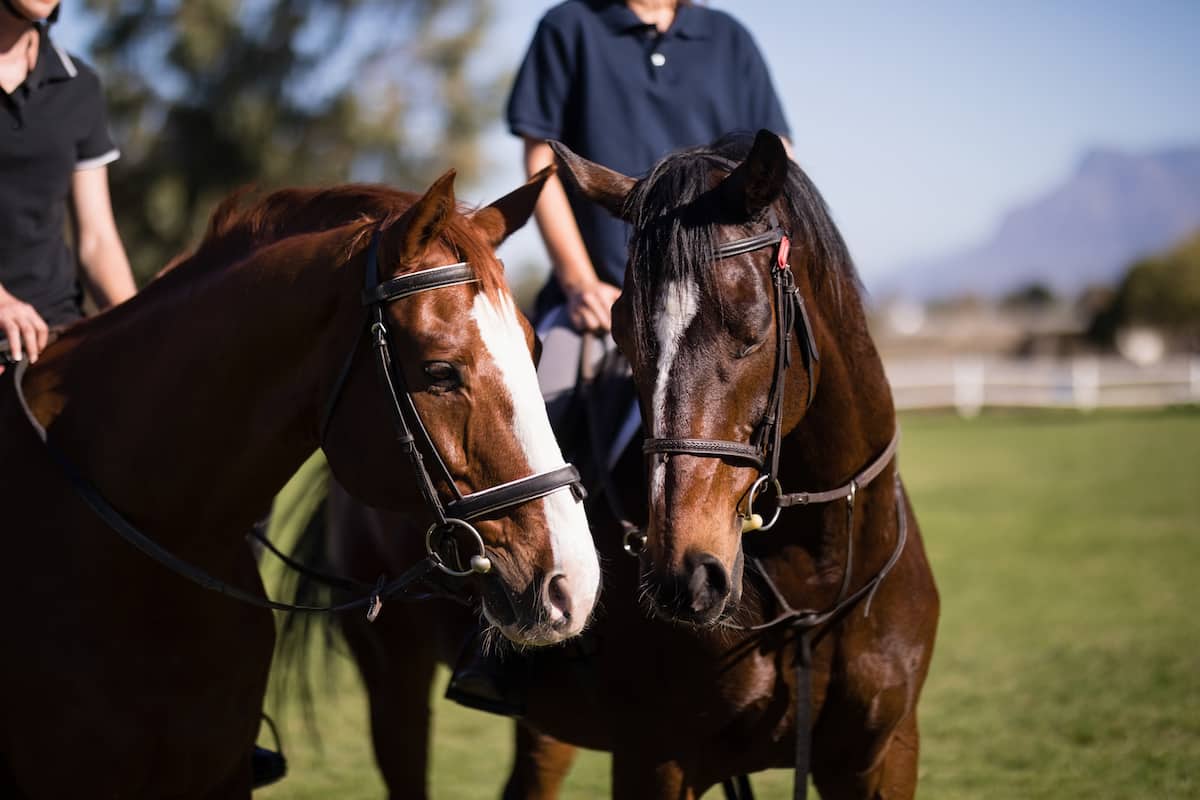
istock.com
Training an off-track Thoroughbred for any discipline usually involves plenty of off-site outings — trail rides, lessons, clinics and shows are important parts of the horse’s reeducation. Most of the time these outings involve horses gathering from multiple farms or even other states and regions. In these cases it’s especially important to minimize your horse’s risk of acquiring or transmitting contagious diseases.
Vaccination: The Cornerstone of Disease Prevention
The University of Minnesota Extension Service defines equine biosecurity as “a set of practices horse owners can take to prevent and reduce the spread of disease.” Of course, the basis of any infectious disease prevention program is vaccination. Veterinarians classify vaccines as “core” — meaning all horses should get them, regardless of housing or travel status — and “risk-based” — meaning their need is dependent on the horse’s likelihood of exposure to diseases via the environment or other horses. The core vaccines protect against diseases that are ubiquitous in the environment: tetanus, Eastern and Western equine encephalomyelitis (EEE/WEE, or “sleeping sickness”), West Nile virus and rabies. The most common risk-based vaccines include equine influenza, equine herpesvirus (EHV or rhinopneumonitis), Potomac horse fever, strangles and, in some areas, botulism. Of these, influenza, EHV and strangles are the most common transmissible illnesses, particularly among horses traveling to venues where many horses congregate.
Influenza and EHV are viruses. Immunizations against them are often combined into the well-known “flu/rhino” vaccine many horses receive twice yearly. Horses with a heavy travel schedule or higher-than-average exposure might get these vaccines more frequently. The EHV portion of the vaccine generally includes EHV-1 and EHV-4 strains. Most commonly, these strains, along with flu, cause respiratory disease characterized by fever, lethargy, loss of appetite, nasal discharge and coughing. However, EHV-1 can also cause a serious neurologic syndrome called equine herpesvirus myeloencephalopathy (EHM). While the currently available EHV vaccines are not proven to protect against this form of the disease, some evidence suggests that in addition to decreasing horses’ risk of contracting EHV, the vaccines reduce viral transmission from infected individuals. Herpesvirus infections commonly become latent, meaning horses become carriers of the virus, sometimes for life, and disease can recur during periods of stress. The Equine Disease Communication Center (EDCC) has reported EHV/EHM cases across the U.S. in spring 2022, making this disease one of the most concerning for owners traveling with their OTTBs.
Strangles is caused by infection with the bacterium Streptococcus equi. Like group A Streptococcus causes “strep throat” in humans, S. equi in horses causes respiratory symptoms and fever. It also commonly causes abscessation of the lymph nodes around the head, throat and neck, which can swell and cause pain and even difficulty breathing. Strangles is highly contagious, and outbreaks can be difficult and tedious to contain. The vaccine is a modified-live product given intranasally that can prevent or greatly reduce the severity of clinical disease.
Thoroughbreds coming off the track have variable vaccine histories, and it can be challenging to obtain accurate records. Most of them have been vaccinated against influenza and EHV as a racetrack requirement, and most have had at least tetanus, EEE/WEE and West Nile virus vaccines annually. If you cannot access accurate vaccine records, ask your veterinarian which vaccines are most appropriate for your area and your horse’s exposure. When dealing with horses coming straight off the track, I recommend updating influenza/EHV if needed, as well as adding strangles, rabies, Potomac horse fever (if appropriate) and boostering if needed.
Biosecurity Guidelines
As humans that have all lived through a multiyear pandemic, we know vaccinations aren’t foolproof. Easy precautions when traveling can offer additional layers of protection against contagious disease. The goal is to prevent sharing nasal secretions — and because horses can’t wear masks, we must rely primarily on social distancing. Avoid nose-to-nose contact with horses that don’t live at the same farm as yours. Never share buckets or water sources. Keep shared hose nozzles out of the water as you’re filling buckets, and if the only water option is dipping from a shared tank, bring jugs of water from your own barn instead.
As much as possible, only allow your horse to closely socialize with horses from his or her home barn. Bring all your own grooming tools — skin diseases such as rain rot (caused by Dermatophilus bacteria) and fungal dermatitis can be spread via shared brushes, blankets, coolers and the like. Teaching your horse to stand tied to your trailer with a haynet can be a great alternative to putting him or her in a stall that was previously inhabited by other horses or in a shared paddock. And, of course, don’t bring your horse anywhere if he or she has clinical signs of illness or if any horses at your own barn or the host facility have shown signs of illness.
What about when you move your horse to a new facility? Barns are highly variable in their ability to effectively quarantine new horses. The American Association of Equine Practitioners (AAEP) Biosecurity Guidelines recommend quarantining each new horse for two to three weeks and monitoring for fever and other signs of communicable disease daily before releasing the horse into the herd. If that is not possible, an alternative option is to have your veterinarian perform a physical exam, administer up-to-date vaccinations and order a fecal egg count to determine parasite shedding status, but you’re still faced with the risk of introducing a horse with subclinical (not showing any signs) infectious disease into the herd.
If a horse at the barn or an event begins showing signs of a contagious disease — fever, nasal discharge, diarrhea or coughing, for instance — immediately isolate the horse as far as possible from general human and equine traffic. Keep everything used for that horse (e.g., buckets, tools, halter, lead, etc.) separate from healthy horses and their gear. Wear designated boots or boot covers, disposable or designated coveralls and disposable gloves, and set up a disinfectant foot bath for people entering and exiting the barn. Most importantly, never handle the sick horse before handling healthy ones. Make the quarantine barn or paddock the last stop as you leave the farm. Wash your hands and change your clothes before returning to care for other horses again. Put up signs to make sure all people at the facility are aware of the isolation area. Have a veterinarian assess the situation as soon as possible to examine the sick horse, determine how best to quarantine exposed horses and recommend monitoring methods — such as twice daily temperature checks — for all horses at the facility.
Disinfection protocols can be time-consuming but worth the trouble if you have or suspect a contagious disease in your barn. The EDCC recommends you start by scrubbing all organic matter off surfaces, including stall walls and floors, mats (and under the mats), water and feed buckets and even crossties. Make sure surfaces are free of dirt, manure, saliva and mucus. If you are using a hose, a regular garden hose nozzle is sufficient for cleaning. The AAEP recommends against using power washers, as a psi greater than 120 can aerosolize pathogens (disease-causing microbes). Allow washed surfaces to dry completely, and then apply the disinfectant. A solution of one part bleach to 10 parts water is effective and easy to mix and apply. Then allow the surface to dry again.
Take-Home Message
Daily biosecurity strategies for most barns and horse owners involve a fairly simple system of checks to make sure horses stay healthy. Having good protocols in place for traveling with your horse is an integral part of maintaining OTTBs during their retraining. Cooperation with barn owners and veterinarians can prevent unpleasant and costly illnesses.
Where To Find Infectious Disease Information
The Equine Disease Communication Center (equinediseasecc.org) is a nonprofit focused on preventing infectious disease in horses in North America and an excellent resource for horse owners and veterinarians. Along with information about diseases and biosecurity, it provides real-time updates on outbreaks and management protocols, similar to the role of the Centers for Disease Control and Prevention for humans. Local university extension services also offer information about best practices for biosecurity, and the American Association of Equine Practitioners has detailed guidelines for best biosecurity practices for equine facilities.
This article was originally published in the Summer 2022 issue of Off-Track Thoroughbred Magazine, the only publication dedicated to the Thoroughbred ex-racehorse in second careers. Want four information-packed issues a year delivered to your door or your favorite digital device? Subscribe now!

